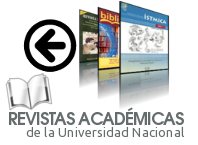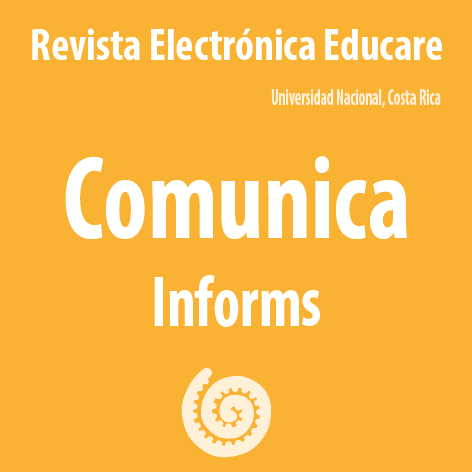Evaluation of the Design and Didactic Development of Three Blended Learning Subjects. A Pilot Plan of the Faculty of Social Sciences at the Universidad Nacional, Costa Rica
DOI:
https://doi.org/10.15359/ree.23-1.6Keywords:
Blended learning, pilot evaluation plan, semi-distance learning, commercial education, administration, didacticsAbstract
This article presents the results of the exploratory pre-experimental evaluation process of design and didactic development of three subjects using the semi-distance learning model or blended learning, through a pilot application plan in bachelor’s degrees of the Faculty of Social Sciences at the Universidad Nacional de Costa Rica. First, the blended learning model was applied. Later, scientific information was collected through a survey of students, a panel discussion with teachers, and an analysis of the contents of the study programs. The results show that the interaction between students and teachers increases through their favorite activities such as forums and tasks, which strengthen the individual and collaborative work and the reflective analysis, aspects that favor building learnings. Various lines of research arise from this study; they are necessary to go in depth, specifically, in quasi-experimental studies. Some of these lines are the following: to show the assumptions of the blended learning and educational factors that favor the development of meaningful learning for the student; to determine what the cognitive processes, carried out in mixed learning environments, are; and to test the positive relationship between the student’s academic performance and the semi-distance didactics.
References
Ahumada, P. (2005). La evaluación auténtica: Un sistema para la obtención de evidencias y vivencias de los aprendizajes. Perspectiva Educacional, Formación de profesores, 45(1), 11-24. Recuperado de http://www.redalyc.org/articulo.oa?id=333329100002
Araya, M. I. (2017). Blended Learning: Modelo didáctico semipresencial en contextos universitarios. Base teórica-metodológica para el diseño de asignaturas en la Facultad de Ciencias Sociales de la Universidad Nacional de Costa Rica (Tesis doctoral). Universidad de Zaragoza, España.
Bartolomé, A. (2008). Entornos de aprendizaje mixto en educación superior. AIESAD RIED RIED. Ried. Revista Iberoamericana de Educación a Distancia, 11(1), 15-51, http://revistas.uned.es/index.php/ried/article/view/955/874
Bernard, R. M., Borokhovski, E., Schmid, R. F., Tamim, R. M. y Abrami, P. C. (2014). A meta-analysis of blended learning and technology use in higher education: From the general to the applied. Journal of Computing in Higher Education, 26(1), 87-122. doi: 10.1007/s12528- 013-9077-3
Bliuc, A.-M., Ellis, R. A., Goodyear, P. y Piggott, L. (2011). A blended learning approach to teaching foreign policy: Student experiences of learning through face-to-face and online discussion and their relationship to academic performance. Computers & Education, 56(3), 856-864. doi: https://doi.org/10.1016/j.compedu.2010.10.027
Campbell, D. T. y Stanley, J. C. (1995). Diseños experimentales y cuasiexperimentales en la investigación social. Buenos Aires: Amorrortu editores.
Campo-Arias, A. y Oviedo, H. C. (2008). Propiedades psicométricas de una escala: La consistencia interna. Revista de Salud Pública, 10(5), 831-839. doi: https://doi.org/10.1590/S0124-00642008000500015
Cohen, L. y Manion, L. (1990). Métodos de investigación educativa. Madrid: La Muralla.
El-Hmoudova, D. y Tejklova, M. (2016). Computer based key language competence development. Procedia - Social and Behavioral Sciences, 217, 57-64. doi: https://doi.org/10.1016/j.sbspro.2016.02.025
España, C. y Canales, A. (2013). La utilidad de las TIC para la promoción de aprendizajes en la educación superior. Teoría de la Educación. Educación y Cultura en la Sociedad de la Información, 14(1), 189-227. Recuperado de http://www.redalyc.org/html/2010/201025739010/
Flick, U. (2012). Introducción a la investigación cualitativa (3ª ed.). Madrid: Morata .
Goulão, F., Melaré, D., Miranda, L. y Morais, C. (Junio de 2012). Estilos de uso del espacio virtual de alumnos de la enseñanza superior. En F. Guerra, R. García-Ruiz, N. González, P. Renés, A. Castro (Coords.), Estilos de parendizaje: Investigaciones y experiencias: V Congreso Mundial de Estilos de Aprendizaje. Santander: Universidad de Cantabria. Recuperado de https://dialnet.unirioja.es/servlet/articulo?codigo=4676070
Hernández, G. (2006). Paradigmas en psicología de la educación. México: Padiós.
Hinojo, M. A. y Fernández, A. (2011). El aprendizaje semipresencial o virtual: Nueva metodología de aprendizaje en educación superior. Revista Latinoamericana de Ciencias Sociales, Niñez y Juventud, 10(1), 159-167. Recuperado de http://www.redalyc.org/pdf/773/77323982008.pdf
House, E. R. (1997). Evaluación, ética y poder. Madrid: Morata.
Kintu, M. J., Zhu, C. y Kagambe, E. (2017). Blended learning effectiveness: The relationship between sudent characteristics, design features and outcomes. International Journal of Educational Technology in Higher Education, 14(7), 1-20. doi: https://doi.org/10.1186/s41239-017-0043-4
Krasnova, T. y Demeshko, M. (2015). Tutor-mediated support in blended learning. Procedia-Social and Behavioral Sciences, 166, 404-408. doi: https://doi.org/10.1016/j.sbspro.2014.12.544
Lin, W.-S. y Wang, C.-H. (2012). Antecedences to continued intentions of adopting e-learning system in blended learning instruction: A contingency framework based on models of information system success and task-technology fit. Computers & Education, 58(1), 88-99. doi: https://doi.org/10.1016/j.compedu.2011.07.008
Lloréns, L., Espinoza, Y. y Castro, M. L. (2013). Criterios de un modelo de diseño instruccional y competencia docente para la educación superior escolarizada a distancia apoyada en TICC. Sinéctica. Revista Electrónica Sinéctica, 41, 1-21. Recuperado de http://www.redalyc.org/articulo.oa?id=99828325008
Monereo, C. (Coord.). (2007). Estrategias de enseñanza y aprendizaje. Formación del profesorado y aplicación en la escuela. Barcelona: Grao.
Pérez, G. (Coord.). (2001). Modelos de investigación cualitativa en educación social y animación sociocultural. Aplicaciones prácticas (2a ed.). Madrid: Narcea.
Renner , D., Laumer, S. y Weitzel, T. (2014). Effectiveness and efficiency of blended learning – A literature review. Twentieth Americas Conference on Information Sysems. Savannah: AISEL. Recuperado de http://aisel.aisnet.org/cgi/viewcontent.cgi?article=1286&context=amcis2014
Sierra-Bravo, R. (2001). Técnicas de investigación social. Teoría y ejercicios. Madrid: Parninfo.
Stufflebeam, D. L. y Shinkfield, A. J. (1995). Evaluación sistemática. Guía teórica y práctica. Madrid: Paidós.
Unesco. (2014). Informe de seguimiento de la EPT en el mundo. Enseñanza y aprendizaje: Lograr la calidad para todos. Paris: Ediciones Unesco. Recuperado de http://unesdoc.unesco.org/images/0022/002256/225654s.pdf
Vieira, D. M. (2011). Estilos de aprendizaje y medios didácticos en contextos virtuales (Tesis doctoral). Universidad Nacional de Educación a Distancia, Madrid, España. Recuperado de http://e-spacio.uned.es/fez/eserv.php?pid=tesisuned:Educacion-Dmelare&dsID=Documento.pdf
Wu, J.-H-, Tennyson, R. D. y Hsia, T.-L. (2010). A study of student satisfaction in a blended e-learning system environment. Computer & Education, 55(1), 155-164. doi: https://doi.org/10.1016/j.compedu.2009.12.012
Downloads
Published
How to Cite
Issue
Section
License
1. In case the submitted paper is accepted for publication, the author(s) FREELY, COSTLESS, EXCLUSIVELY AND FOR AN INDEFINITE TERM transfer copyrights and patrimonial rights to Universidad Nacional (UNA, Costa Rica). For more details check the Originality Statement and Copyright Transfer Agreement
2. REUTILIZATION RIGHTS: UNA authorizes authors to use, for any purpose (among them selfarchiving or autoarchiving) and to publish in the Internet in any electronic site, the paper´'s final version, both approved and published (post print), as long as it is done with a non commercial purpose, does not generate derivates without previous consentment and recognizes both publisher's name and authorship.
3. The submission and possible publication of the paper in the Educare Electronic Journal is ruled by the Journal’s editorial policies, the institutional rules of Universidad Nacional and the laws of the Republic of Costa Rica. Additionally, any possible difference of opinion or future dispute shall be settled in accordance with the mechanisms of Alternative Dispute Resolution and the Costa Rican Jurisdiction.
4. In all cases, it is understood that the opinions issued are those of the authors and do not necessarily reflect the position and opinion of Educare, CIDE or Universidad Nacional, Costa Rica. It is also understood that, in the exercise of academic freedom, the authors have carried out a rogorous scientific-academic process of research, reflection and argumentation thar lays within the thematic scope of interest of the Journal.
5. The papers published by Educare Electronic Journal use a Creative Commons License:













 The articles published by Educare Electronic Journal can be shared with a Creative Commons License:
The articles published by Educare Electronic Journal can be shared with a Creative Commons License: 



